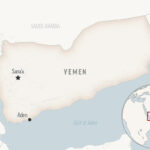A high-stakes mission from the United Nations’ nuclear watchdog reached a Russian-controlled power plant in Ukraine on Thursday afternoon amid reports of heavy fighting there.
The International Atomic Energy Agency has long sought access to the Zaporizhzhia nuclear power plant, Europe’s largest, since invading Russian troops overran the site and the surrounding town of Enerhodar in southeastern Ukraine in early March. The Ukrainian workers have been left in place to keep the plant operating, as it supplies electricity across the war-torn country, but the site is now on the frontline between Russian-occupied and Ukrainian-controlled territory. Moscow and Kyiv have traded accusations of shelling at or near the plant in recent days and weeks, fueling fears that the conflict could spark a radiation disaster.
IAEA Rafael Grossi, who is leading a team of over a dozen experts sent to inspect the besieged plant, said earlier Thursday that they were “aware” of the high risk posed by the “increased military activity in the area” between Russian and Ukrainian forces.
“There has been increased military activity, including this morning, until very recently, a few minutes ago. I have been briefed by the Ukrainian regional military commander here about that and the inherent risks,” Grossi told reporters as he and his team left their hotel in the city of Zaporizhzhia, north of Enerhodar, across the Dnipro River.
“But, weighing the pros and cons, and having come so far, we are not stopping,” he added. “We are moving now.”

IAEA Director General Rafael Mariano Grossi and fellow officials try to negotiate access to Zaporizhzhia nuclear power plant, in Zaporizhzhia, Ukraine, Sept. 1, 2022.
IAEA via Reuters
While acknowledging the risks, Grossi said his team had the “minimum conditions” to forge on with the final and dangerous leg of their journey. He told reporters to “wish us luck.”
“We know that there is an area, as you know, the so-called grey zone, where the last line of the Ukrainian defense comes, and before the first line of the Russian occupying forces begins, where the risks are significant,” he said. “At the same time, we consider that we have the minimum conditions to move, accepting that the risks are very, very high. Still, myself and the team, we believe that we can proceed with this. We have a very important mission to accomplish.”
Upon arrival, the team plans to immediately start “an assessment of the security and the safety situation at the plant, as it is right now,” according to Grossi.
“We are going to be liaising and consulting with the staff at the facility. And I am going to consider the possibility of establishing a continued presence of the IAEA at the plant, which we believe is indispensable to stabilize the situation and to get regular, reliable, impartial, neutral updates of what the situation is there,” he added. “It’s very important that the world knows what’s happening here.”
A few hours later, the IAEA announced via Twitter that its “Support and Assistance Mission … has just arrived at Zaporizhzhya Nuclear Power Plant to conduct indispensable nuclear safety and security and safeguards activities.”
Grossi and his team landed in Kyiv earlier this week, where they met with with Ukrainian President Volodymyr Zelensky, before making their way to the Zaporizhzhia region in a convoy of U.N.-marked vehicles.
When asked by reporters on Wednesday if it was possible to demilitarize the plant, Grossi said it was “a matter of political will” and that his mission is to preserve the biggest nuclear power station in both Ukraine and Europe. He emphasized that his team would be operating in Ukrainian sovereign territory but in cooperation with Russian forces.
Asked if he thought Russian troops would really give his team full access, Grossi told reporters the IAEA was on a “technical mission” and that he was confident they could work “on both sides.”
ABC News’ Dragana Jovanovic, Kuba Kaminski, Nataliya Kushniir and Joseph Simonetti contributed to this report.



